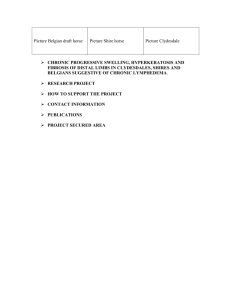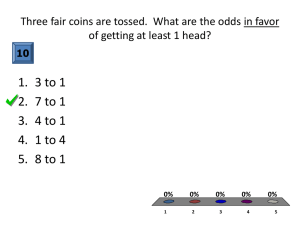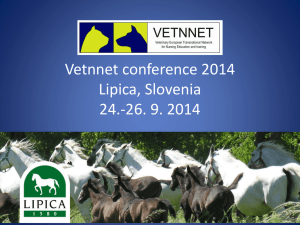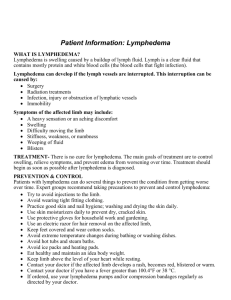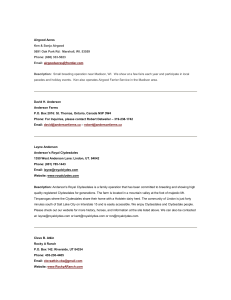Drafthorsewebpage
advertisement
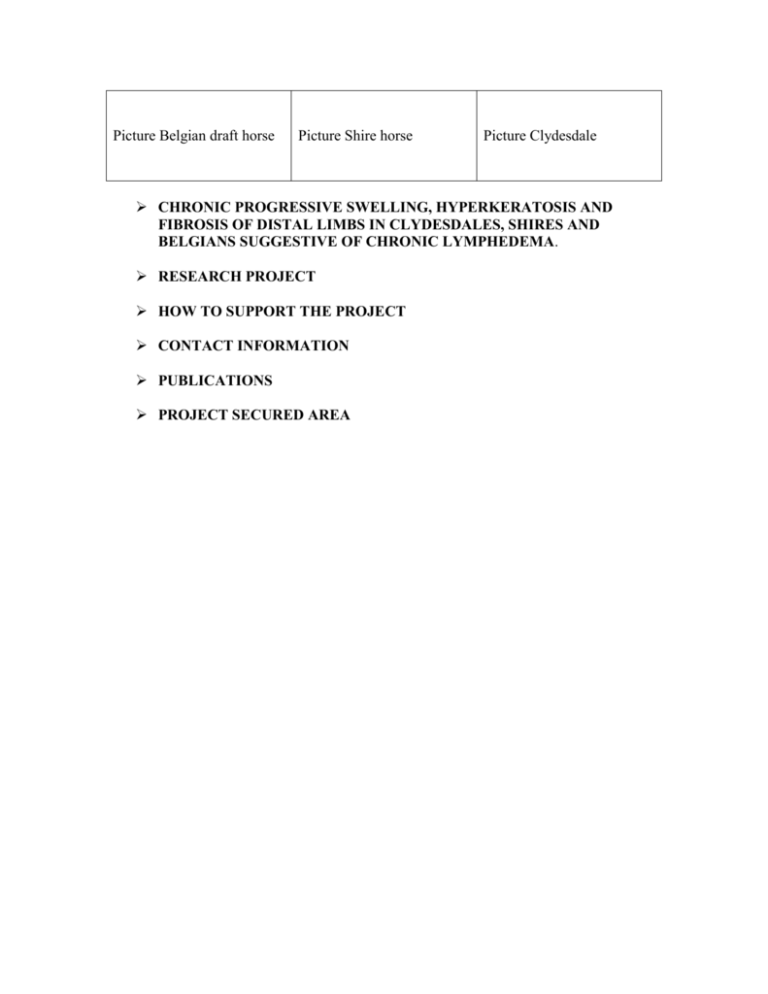
Picture Belgian draft horse Picture Shire horse Picture Clydesdale CHRONIC PROGRESSIVE SWELLING, HYPERKERATOSIS AND FIBROSIS OF DISTAL LIMBS IN CLYDESDALES, SHIRES AND BELGIANS SUGGESTIVE OF CHRONIC LYMPHEDEMA. RESEARCH PROJECT HOW TO SUPPORT THE PROJECT CONTACT INFORMATION PUBLICATIONS PROJECT SECURED AREA CHRONIC PROGRESSIVE SWELLING, HYPERKERATOSIS AND FIBROSIS OF DISTAL LIMBS IN CLYDESDALES, SHIRES AND BELGIANS SUGGESTIVE OF CHRONIC LYMPHEDEMA. A condition characterized by progressive swelling, hyperkeratosis and fibrosis of distal limbs has been recognized in Shires, Clydesdales and Belgian Draft horses. This chronic progressive disease starts at an early age, progresses throughout the life of the horse and often ends in disfigurement and disability of the limbs which inevitably leads to the horse’s premature death. The pathologic changes and clinical signs closely resemble a condition known in humans as chronic lymphedema or elephantiasis nostras verrucosa. The lower leg swelling is caused by abnormal functioning of the lymphatic system in the skin, which results in chronic lymphedema (swelling), fibrosis, a compromised immune system and subsequent secondary infections of the skin. Based on preliminary research, it appears that a similar pathogenic mechanism is involved in the disease that affects these specific draft horse breeds. Te clinical signs of this disease are highly variable. The earliest lesions are characterized by skin thickening and crusting; both are often visible only after clipping the long feathering. Secondary infections develop very easily in these horse's legs and usually consist of either chorioptic mange or bacterial infections. Both dark and white skin on the lower legs are equally affected. These lesions are consistent with pastern dermatitis, a process also seen in other breeds. In Shires, Clydesdales and Belgians however, these lesions do not respond well to therapy. As the condition becomes more chronic, the lower leg enlargement becomes permanent and the swelling is firm on palpation. More thick skin folds and large, poorly defined, firm nodules develop. The nodules may become quite large and often are described as "golf ball" or even "baseball" in size. Both skin folds and nodules first develop in the back of the pastern area. With progression, they may extend and encircle the entire lower leg. The nodules become a mechanical problem because they interfere with free movement and frequently are injured during exercise. This disease often progresses to include massive secondary infections that produce copious amounts of foul-smelling exudates, generalized illness, debilitation and even death. Picture early lesion Picture chronic lesion Picture distribution lesion RESEARCH For the last two years, a Center for Equine Health scientific team, led by Dr. Hilde De Cock and Dr. Verena Affolter, has been studying this disease. They have employed several different investigative techniques in an attempt to find the underlying cause of this serious and debilitating disease. These researchers utilized histopathologic and radiographic imaging techniques to examine the skin, blood and lymph flow of the distal limbs of normal and affected draft horses. Detailed examinations of tissues from pathological specimens and skin biopsies were conducted using several different methodologies in an attempt to define and delineate the basic pathogenic features of the condition. This research team now understands that this condition is primarily a lymphatic disease, and that the pastern dermatitis that draft horse owners have been struggling with for years is a secondary result due to the body's inability to properly remove fluids and oxygenate the skin of the lower leg. We know that the lymph system breaks down over time and that protein-rich fluid leaks into the tissues of the lower leg, which results in fibrosis of the tissues under the skin and thickening of the skin itself. The clinical signs and pathologic changes resemble closely a condition known in humans as chronic lymphedema or elephantiasis nostras verrucosa. In order to develop a successful treatment or management strategy for these horses the research team recently started a thorough research project in cooperation with Professor Barry Starcher from the University of Texas Health Center at Tyler, Texas, USA and Professor Richard Ducatelle from The University of Gent, Merelbeke, Belgium. The project is generously sponsored by …………..GREG, SHOULD WE MENTION THE SPONSORS????????? In the next couple of years this group of researchers will focus on developing better diagnostic tools to detect the disease in the early stages, and concurrently significant effort will be put in complete characterization of the disease and better understanding of the pathogenic mechanism underlying this disease. HOW TO SUPPORT OUR RESEARCH SAMPLES MONEY CONTACT INFORMATION Additional information can be obtained from the following persons: Dr. Hilde De Cock: hedecock@ucdavis.edu Dr. V. Affolter: vkaffolter@ucdavis.edu Dr. G. Ferraro: glferraro@ucdavis.edu LINKS Link to horse report Volume 21, Number 2, April 2003 Link to horse report Volume 21, Number 2, April 2003 PUBLICATIONS 1. Van den Eynde H. The Belgian Draft Horse has Painful Limbs (Belgisch trekpaard heft zere benen). Science section of a Belgian newspaper "De Standaard" 2002; November 29. 2. Verstraete J. The Belgian draft horse in danger (Belgisch trekpaard bedreigd). Gent Universiteit 2003;17(4):26-29. 3. De Brauwer P. Health status of the limbs of Belgian draft horses (Gezondheid van de benen van trekpaarden). Landbouwleven February, 14th, 2003. 4. Equus Scientific papers: De Cock et al. Progressive swelling, hyperkeratosis and fibrosis of distal limbs in Clydesdales, Shires and Belgian draft horses suggestive of primary lymphedema" accepted in Lymphatic Research and Biology, Vol. 1 # 3. PROJECT SECURED AREA Will only be accessible by Hilde De Cock, Verena Affolter, Greg Ferraro, Jim MacLachlan, Leen Vanbrantegem and Barry Starcher Will contain space for input new data and space for downloading most recent data.
